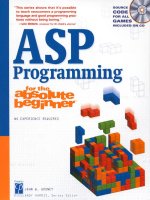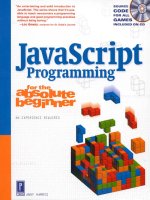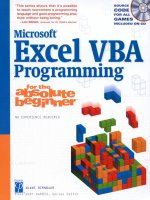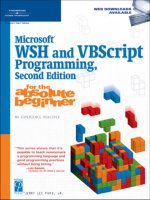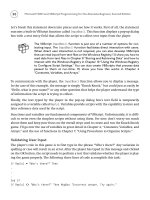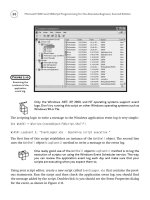C Programming for the Absolute Beginner phần 8 ppt
Bạn đang xem bản rút gọn của tài liệu. Xem và tải ngay bản đầy đủ của tài liệu tại đây (14.97 MB, 32 trang )
} emp;
emp emp1[5];
To access individual elements in a structure array, you need to provide the array element
number surrounded by brackets. To access individual structure members, you need to supply
the dot operator followed by the structure member name, as revealed in the next segment of
code, which uses the
strcpy() function to copy the text “Spencer” into the memory reserved
by the structure member.
strcpy(emp1[0].fname, "Spencer");
The next program and its output, shown in Figure 9.2, demonstrate arrays of structures in
more detail.
#include <stdio.h>
#include <string.h>
typedef struct scores {
char name[10];
int score;
} s;
main()
{
s highScores[3];
int x;
//assign values to members
strcpy(highScores[0].name, "Hunter");
highScores[0].score = 40768;
strcpy(highScores[1].name, "Kenya");
highScores[1].score = 38565;
strcpy(highScores[2].name, "Apollo");
Chapter 9 • Introduction to Data Structures
209
highScores[2].score = 35985;
//print array content
printf("\nTop 3 High Scores\n");
for ( x = 0; x < 3; x++ )
printf("\n%s\t%d\n", highScores[x].name, highScores[x].score);
} //end main
FIGURE 9.2
Creating and using
arrays of
structures.
P
ASSING
S
TRUCTURES TO
F
UNCTIONS
To utilize the power of structures, you need to understand how they are passed to functions
for processing. Structures can be passed to functions in a multitude of ways, including passing
by value for read-only access and passing by reference for modifying structure member
contents.
Passing by value
protects an incoming variable’s value by sending a copy of the
original data rather than the actual variable to the function.
Passing by reference
sends a variable’s memory address to a function, which
allows statements in the function to modify the original variable’s memory
contents.
Passing Structures by Value
Like any parameter passed by value, C makes a copy of the incoming structure variable for the
function to use. Any modifications made to the parameter within the receiving function are
not made to the original variable’s value. To pass a structure by value to a function, you need
only to supply the function prototype and function definition with the structure tag (or the
TIP
TIP
C Programming for the Absolute Beginner, Second Edition
210
alias if typedef is used). This process is demonstrated in the next program and its correspond-
ing output in Figure 9.3.
#include <stdio.h>
#include <string.h>
typedef struct employee {
int id;
char name[10];
float salary;
} e;
void processEmp(e); //supply prototype with structure alias name
main()
{
e emp1 = {0,0,0}; //Initialize members
processEmp(emp1); //pass structure by value
printf("\nID: %d\n", emp1.id);
printf("Name: %s\n", emp1.name);
printf("Salary: $%.2f\n", emp1.salary);
} // end main
void processEmp(e emp) //receives a copy of the structure
{
emp.id = 123;
strcpy(emp.name, "Sheila");
emp.salary = 65000.00;
} //end processEmp
Chapter 9 • Introduction to Data Structures
211
FIGURE 9.3
Passing a structure
by value to a
function does not
change the original
values of the
structure’s
members.
As you can see in Figure 9.3, the structure's members still contain their initialization values
even though the structure members appear to be updated in the
processEmp() function. The
structure’s original member contents weren’t really modified. In fact, only a copy of the
structure’s members were accessed and modified. In other words, passing by value causes
the
processEmp() function to modify a copy of the structure rather than its original member
contents.
Passing Structures by Reference
Passing structures by reference requires a bit more knowledge and adherence to C rules and
regulations. Before learning how to pass structures by reference, you need to learn a second
means for accessing members of structures. In this approach, members can be accessed via
the structure pointer operator (
->). The structure pointer operator is a dash followed by the
greater-than sign with no spaces in between, as demonstrated next.
emp->salary = 80000.00;
The structure pointer operator is used to access a structure member through a pointer. This
form of member access is useful when you have created a pointer of structure type and need
to indirectly reference a member’s value.
The next program demonstrates how a pointer of structure type is created and its members
are accessed via the structure pointer operator.
#include <stdio.h>
#include <string.h>
main()
{
C Programming for the Absolute Beginner, Second Edition
212
typedef struct player {
char name[15];
float score;
} p;
p aPlayer = {0, 0}; // create instance of structure
p *ptrPlayer; // create a pointer of structure type
ptrPlayer = &aPlayer; // assign address to pointer of structure type
strcpy(ptrPlayer->name, "Pinball Wizard"); // access through indirection
ptrPlayer->score = 1000000.00;
printf("\nPlayer: %s\n", ptrPlayer->name);
printf("Score: %.0f\n", ptrPlayer->score);
} //end main
When you understand the structure pointer operator, passing structures by reference is really
quite easy. For the most part, structures passed by reference follow the same rules as any other
variable passed by reference. Simply tell the function prototype and its definition to expect
a pointer of structure type and remember to use the structure pointer operator (
->) inside
your functions to access each structure member.
To further demonstrate these concepts, study the next program's implementation.
#include <stdio.h>
#include <string.h>
typedef struct employee {
int id;
char name[10];
float salary;
} emp;
void processEmp(emp *);
Chapter 9 • Introduction to Data Structures
213
main()
{
emp emp1 = {0, 0, 0};
emp *ptrEmp;
ptrEmp = &emp1;
processEmp(ptrEmp);
printf("\nID: %d\n", ptrEmp->id);
printf("Name: %s\n", ptrEmp->name);
printf("Salary: $%.2f\n", ptrEmp->salary);
} // end main
void processEmp(emp *e)
{
e->id = 123;
strcpy(e->name, "Sheila");
e->salary = 65000.00;
} //end processEmp
Figure 9.4 demonstrates the output of the previous program and more specifically demon-
strates how passing by reference allows functions to modify the original contents of variables,
including structure variables.
Passing Arrays of Structures
Unless otherwise specified, passing arrays of structures to functions is automatically passing
by reference; it is also known as passing by address. This is true because an array name is
really nothing more than a pointer!
C Programming for the Absolute Beginner, Second Edition
214
FIGURE 9.4
Passing structures
by reference
allows a called
function to modify
the original
contents of the
structure’s
members.
To pass an array of structures, simply supply the function prototype with a pointer to the
structure, as demonstrated in the next modified program.
#include <stdio.h>
#include <string.h>
typedef struct employee {
int id;
char name[10];
float salary;
} e;
void processEmp( e * ); //supply prototype with pointer of structure type
main()
{
e emp1[3] = {0,0,0};
int x;
processEmp( emp1 ); //pass array name, which is a pointer
for ( x = 0; x < 3; x++ ) {
printf("\nID: %d\n", emp1[x].id);
Chapter 9 • Introduction to Data Structures
215
printf("Name: %s\n", emp1[x].name);
printf("Salary: $%.2f\n\n", emp1[x].salary);
} //end loop
} // end main
void processEmp( e * emp ) //function receives a pointer
{
emp[0].id = 123;
strcpy(emp[0].name, "Sheila");
emp[0].salary = 65000.00;
emp[1].id = 234;
strcpy(emp[1].name, "Hunter");
emp[1].salary = 28000.00;
emp[2].id = 456;
strcpy(emp[2].name, "Kenya");
emp[2].salary = 48000.00;
} //end processEmp
As shown in Figure 9.5, the processEmp() function can modify the structure’s original member
contents using pass by reference techniques.
FIGURE 9.5
Passing an array of
structures by
reference.
C Programming for the Absolute Beginner, Second Edition
216
You do not need to use pointers when passing an array of structures to a function
because array names
are
pointers! Structure arrays can also be passed by refer-
ence simply by telling the function prototype and function definition to receive
an array of structure type using empty brackets, as demonstrated next.
void processEmp( e [] ); //function prototype
void processEmp( e emp[] ) //function definition
{
}
Passing an array to a function is actually passing the first memory address of the
array. This type of action produces a simulated pass by reference outcome that
allows the user to modify each structure and its members directly.
U
NIONS
Although similar to structures in design and use, unions provide a more economical way to
build objects with attributes (members) that are not required to be in use at the same time.
Whereas structures reserve separate memory segments for each member when they are cre-
ated, a union reserves a single memory space for its largest member, thereby providing a
memory-saving feature for members to share the same memory space.
Unions are created with the keyword
union and contain member definitions similar to that
of structures. The next block of program code creates a union definition for a phone book.
union phoneBook {
char *name;
char *number;
char *address;
};
Like structures, union members are accessed via the dot operator, as the next program
demonstrates.
#include <stdio.h>
union phoneBook {
TIP
Chapter 9 • Introduction to Data Structures
217
char *name;
char *number;
char *address;
};
struct magazine {
char *name;
char *author;
int isbn;
};
main()
{
union phoneBook aBook;
struct magazine aMagazine;
printf("\nUnion Details\n");
printf("Address for aBook.name: %p\n", &aBook.name);
printf("Address for aBook.number: %p\n", &aBook.number);
printf("Address for aBook.address: %p\n", &aBook.address);
printf("\nStructure Details\n");
printf("Address for aMagazine.name: %p\n", &aMagazine.name);
printf("Address for aMagazine.author: %p\n", &aMagazine.author);
printf("Address for aMagazine.isbn: %p\n", &aMagazine.isbn);
} //end main
The output of the preceding program is shown in Figure 9.6, which reveals how memory
allocation is conducted between unions and structures. Each member of the union shares the
same memory space.
C Programming for the Absolute Beginner, Second Edition
218
FIGURE 9.6
Comparing
memory
allocation
between
structures and
unions.
T
YPE
C
ASTING
Although it is not supported by all high-level programming languages, type casting is a pow-
erful feature of C. Type casting enables C programmers to force one variable of a certain type
to be another type, an important consideration especially when dealing with integer division.
For all its power, type casting is simple to use. As demonstrated next, just surround a data-
type name with parentheses followed by the data or variable for which you want to type cast.
int x = 12;
int y = 5;
float result = 0;
result = (float) x / (float) y;
Hollywood does a lot of type casting!
The next program and its output (shown in Figure 9.7) further demonstrate the use of type
casting, and in addition show what happens when type casting is not leveraged during integer
division.
#include <stdio.h>
main()
{
int x = 12;
int y = 5;
TIP
Chapter 9 • Introduction to Data Structures
219
printf("\nWithout Type-Casting\n");
printf("12 \\ 5 = %.2f\n", x/y);
printf("\nWith Type-Casting\n");
printf("12 \\ 5 = %.2f\n", (float) x / (float) y);
} //end main
Remember that the backslash (\) is a reserved and special character in the
printf() function. To incorporate a backslash character in your output, use the
\\ conversion specifier shown next.
printf("12 \\ 5 = %.2f\n", (float) x / (float) y);
FIGURE 9.7
Conducting
integer division
with and without
type casting.
As you might expect, type casting is not limited to numbers. You can also type cast numbers
to characters and characters to numbers, as shown next.
#include <stdio.h>
main()
{
int number = 86;
char letter = 'M';
printf("\n86 type-casted to char is: %c\n", (char) number);
TIP
C Programming for the Absolute Beginner, Second Edition
220
printf("\n'M' type-casted to int is: %d\n ", (int) letter);
} //end main
Figure 9.8 demonstrates the output from the preceding program in which a number is type
casted to a character and a character is type casted to a number.
C always prints the ASCII equivalent of a letter when using the %n conversion
specifier with a character equivalent. In addition, C always prints the character
equivalent of an ASCII number when using the
%c conversion specifier with an
ASCII equivalent.
FIGURE 9.8
Type casting
numbers to
characters and
characters to
numbers.
C
HAPTER
P
ROGRAM
—C
ARD
S
HUFFLE
The Card Shuffle program uses many chapter-based concepts, such as structures, arrays of
structures, and passing structures to functions, to build an easy card-shuffling program.
Specifically, the Card Shuffle program initializes 52 poker cards using an array of structures.
It then uses various techniques, such as random numbers and user-defined functions, to build
a shuffle routine, which after shuffling deals five random cards.
FIGURE 9.9
Using chapter-
based concepts to
build the Card
Shuffle program.
TIP
Chapter 9 • Introduction to Data Structures
221
After studying the Card Shuffle program you should be able to use it in your own card games
to shuffle and deal cards for Poker games and others, such as Five Card Draw, Black Jack.
All of the code required to build the Card Shuffle program is shown next.
#include <stdio.h>
#include <time.h>
#include <string.h>
//define new data type
typedef struct deck {
char type[10];
char used;
int value;
} aDeck; //end type
//function prototype
void shuffle( aDeck * );
main()
{
int x,y;
aDeck myDeck[52];
srand( time( NULL ) );
//initialize structure array
for ( x = 0; x < 3; x++ ) {
for ( y = 0; y < 13; y++ ) {
switch (x) {
case 0:
strcpy(myDeck[y].type, "diamonds");
C Programming for the Absolute Beginner, Second Edition
222
myDeck[y].value = y;
myDeck[y].used = 'n';
break;
case 1:
strcpy(myDeck[y + 13].type, "clubs");
myDeck[y + 13].value = y;
myDeck[y + 13].used = 'n';
break;
case 2:
strcpy(myDeck[y + 26].type, "hearts");
myDeck[y + 26].value = y;
myDeck[y + 26].used = 'n';
break;
case 3:
strcpy(myDeck[y + 39].type, "spades");
myDeck[y + 39].value = y;
myDeck[y + 39].used = 'n';
break;
} //end switch
} // end inner loop
} // end outer loop
shuffle( myDeck );
} //end main
void shuffle( aDeck * thisDeck )
{
int x;
Chapter 9 • Introduction to Data Structures
223
int iRnd;
int found = 0;
system("clear");
printf("\nYour five cards are: \n\n");
while ( found < 5 ) {
iRnd = rand() % 51;
if ( thisDeck[iRnd].used == 'n' ) {
switch (thisDeck[iRnd].value) {
case 12:
printf("Ace of %s\n", thisDeck[iRnd].type);
break;
case 11:
printf("King of %s\n", thisDeck[iRnd].type);
break;
case 10:
printf("Queen of %s\n", thisDeck[iRnd].type);
break;
case 9:
printf("Jack of %s\n", thisDeck[iRnd].type);
break;
default:
printf("%d of ", thisDeck[iRnd].value + 2);
printf("%s\n", thisDeck[iRnd].type);
break;
} // end switch
thisDeck[iRnd].used = 'y';
C Programming for the Absolute Beginner, Second Edition
224
found = found + 1;
} //end if
} // end while loop
} //end shuffle
S
UMMARY
• Structures are a collection of variables related in nature, but not necessarily in data type.
• Structures are most commonly used to define an object—a person, a place, a thing—or
similarly a record in a database or file.
• The first process in creating a structure is to build the structure definition using the
struct keyword followed by braces, with individual variables defined as members.
• Members of structures are the individual elements or variables that make up a collection
of variables.
• Structure tags identify the structure and can be used to create instances of the structure.
• When structure definitions are created using the
struct keyword, memory is not allo-
cated for the structure until an instance of the structure is created.
•The
typedef keyword is used for creating structure definitions to build an alias relation-
ship with the structure tag (structure name). It provides a shortcut for programmers
when creating instances of the structure.
• To create an array of structures, supply the desired number of array elements sur-
rounded by brackets after the structure definition.
• Structures can be passed to functions via pass by value for read-only access and pass by
reference for modifying structure member contents.
• Passing by value protects an incoming variable’s value by sending a copy of the original
data rather than the actual variable to the function.
• Passing by reference sends a variable’s memory address to a function, which allows
statements in the function to modify the original variable’s memory contents.
• The structure pointer operator is a dash followed by the greater-than sign with no space
in between (
->).
• The structure pointer operator is used to access a structure member through a pointer.
• Passing arrays of structures to functions is automatically passing by reference; it is also
known as passing by address. This is true because an array name is a pointer.
Chapter 9 • Introduction to Data Structures
225
• Unions provide a more economical way to build objects with attributes by reserving a
single memory space for its largest member.
• Type casting enables C programmers to force one variable of a certain type to be another
type.
Challenges
1. Create a structure called car with the following members:
•
make
•
model
•
year
•
miles
Create an instance of the
car
structure named
myCar
and assign
data to each of the members. Print the contents of each
member to standard output using the
printf()
function.
2. Using the
car
structure from challenge number one, create a
structure array with three elements named
myCars
. Populate
each structure in the array with your favorite car model
information. Use a
for
loop to print each structure detail in the
array.
3. Create a program that uses a structure array to hold contact
information for your friends. The program should allow the
user to enter up to five friends and print the phone book’s
current entries. Create functions to add entries in the phone
book and to print valid phone book entries. Do not display
phone book entries that are invalid or
NULL (0)
.
C Programming for the Absolute Beginner, Second Edition
226
10
C HAP TE R
DYNAMIC MEMORY
ALLOCATION
n this chapter I will show you how C uses system resources to allocate,
reallocate, and free memory. You will learn basic memory concepts and
also how C library functions and operators can take advantage of system
resources, such as RAM and virtual memory.
Specifically, this chapter covers the following topics:
• Memory concepts continued
•
sizeof
•
malloc()
•
calloc()
•
realloc()
MEMORY CONCEPTS CONTINUED
This chapter is dedicated to discussing dynamic memory concepts, such as allo-
cating, reallocating, and freeing memory using the functions
malloc()
,
calloc()
,
realloc()
, and
free()
. This section specifically reviews essential memory concepts
that directly relate to how these functions receive and use memory.
Software programs, including operating systems, use a variety of memory imple-
mentations, including virtual memory and RAM. Random access memory (RAM)
I
provides a volatile solution for allocating, storing, and retrieving data. RAM is considered
volatile because of its inability to store data after the computer loses power (shuts down).
Another volatile memory storage area is called virtual memory. Essentially, virtual memory
is a reserved section of your hard disk in which the operating system can swap memory seg-
ments. Virtual memory is not as efficient as random access memory, but it provides an
impression to the CPU that it has more memory than it really does. Increasing memory
resources through virtual memory provides the operating system an inexpensive solution for
dynamic memory demands.
Virtual memory
increases the perception of more memory by using hard-disk
space for swapping memory segments.
Stack and Heap
Using a combination of RAM and virtual memory, all software programs use their own area
of memory called the stack. Every time a function is called in a program, the function’s vari-
ables and parameters are pushed onto the program’s memory stack and then pushed off or
“popped” when the function has completed or returned.
Used for storing variable and parameter contents,
memory stacks
are dynamic
groupings of memory that grow and shrink as each program allocates and de-
allocates memory.
After software programs have terminated, memory is returned for reuse for other software
and system programs. Moreover, the operating system is responsible for managing this realm
of unallocated memory, known as the heap. Software programs that can leverage memory-
allocating functions like
malloc()
,
calloc()
, and
realloc()
use the heap.
The
heap
is an area of unused memory managed by the operating system.
Once a program frees memory, it is returned back to the heap for further use by the same
program or other programs.
In a nutshell, memory allocating functions and the heap are extremely important to C pro-
grammers because they allow you to control a program’s memory consumption and alloca-
tion. The remainder of this chapter will show you how to retrieve and return memory to and
from the heap.
TIP
TIP
TIP
228
C Programming for the Absolute Beginner, Second Edition
SIZEOF
There will be occasions when you need to know how large a variable or data type is. This is
especially important in C, because C allows programmers to create memory resources dynam-
ically. More specifically, it is imperative for C programmers to know how many bytes a system
uses to store data, such as integers, floats, or doubles, because not all systems use the same
amount of space for storing data. The C standard library provides the
sizeof
operator to assist
programmers in this type of situation. When used in your programs, the
sizeof
operator will
help you build a more system-independent software program.
The
sizeof
operator takes a variable name or data type as an argument and returns the num-
ber of bytes required to store the data in memory. The next program, and its output shown
in Figure 10.1, demonstrates a simple use of the
sizeof
operator.
#include <stdio.h>
main()
{
int x;
float f;
double d;
char c;
typedef struct employee {
int id;
char *name;
float salary;
} e;
printf("\nSize of integer: %d bytes\n", sizeof(x));
printf("Size of float: %d bytes\n", sizeof(f));
printf("Size of double %d bytes\n", sizeof(d));
printf("Size of char %d byte\n", sizeof(c));
printf("Size of employee structure: %d bytes\n", sizeof(e));
} //end main
Chapter 10 • Dynamic Memory Allocation
229
FIGURE 10.1
Using the sizeof
operator to
determine storage
requirements.
The
sizeof
operator can take either a variable name or a data type, as shown next.
int x;
printf("\nSize of integer: %d bytes\n", sizeof(x)); //valid variable name
printf("\nSize of integer: %d bytes\n", sizeof(int)); //valid data type
The
sizeof
operator can also be used to determine the memory requirements of arrays. Using
simple arithmetic, you can determine how many elements are contained in an array by divid-
ing the array size by the size of the array data type, as demonstrated in the next program and
its output in Figure 10.2.
#include <stdio.h>
main()
{
int array[10];
printf("\nSize of array: %d bytes\n", sizeof(array));
printf("Number of elements in array ");
printf("%d\n", sizeof(array) / sizeof(int));
} //end main
230
C Programming for the Absolute Beginner, Second Edition
FIGURE 10.2
Using the sizeof
operator and
simple arithmetic
to determine the
number of
elements in an
array.
MALLOC()
Sometimes it is impossible to know exactly how much memory your program will need for
a given function. Fixed-sized arrays may not be large enough to hold the amount of data you
are requesting to store. For example, what would happen if you created an eight-element,
fixed-size character array to hold a user’s name, and the user enters the name “Alexandria”—
a 10-character name with an 11th character required for null. Best-case scenario: You incor-
porated error checking in your program to prevent a user from entering a string larger than
eight characters. Worst-case scenario: The user’s information is sent elsewhere in memory,
potentially overwriting other data.
There are many reasons for dynamically creating and using memory, such as creating and
reading strings from standard input, dynamic arrays, and other dynamic data structures such
as linked lists. C provides a few functions for creating dynamic memory, one of which is the
malloc()
function. The
malloc()
function is part of the standard library
<stdlib.h>
and takes
a number as an argument. When executed,
malloc()
attempts to retrieve designated memory
segments from the heap and returns a pointer that is the starting point for the memory
reserved. Basic
malloc()
use is demonstrated in the next program.
#include <stdio.h>
#include <stdlib.h>
main()
{
char *name;
name = malloc(80);
} //end main
Chapter 10 • Dynamic Memory Allocation
231
The preceding program’s use of
malloc()
is not quite complete because some C compilers may
require that you perform type casting when assigning dynamic memory to a variable. To
eliminate potential compiler warnings, I will modify the previous program to simply use a
pointer of type
char
in a type cast, as demonstrated next.
#include <stdio.h>
#include <stdlib.h>
main()
{
char *name;
name = (char *) malloc(80);
} //end main
The
malloc()
function returns a null pointer if it is unsuccessful in allocating
memory.
Better yet, we should be more specific when creating dynamic memory by explicitly telling
the system the size of the data type for which we are requesting memory. In other words, we
should incorporate the
sizeof
operator in our dynamic memory allocation, as shown next.
#include <stdio.h>
#include <stdlib.h>
main()
{
char *name;
name = (char *) malloc(80 * sizeof(char));
} //end main
Using the
sizeof
operator explicitly tells the system that you want 80 bytes of type
char
, which
happens to be a 1-byte data type on most systems.
HINT
232
C Programming for the Absolute Beginner, Second Edition
You should also always check that
malloc()
was successful before attempting to use the mem-
ory. To test the
malloc()
function’s outcome, simply use an
if
condition to test for a
NULL
pointer, as revealed next.
#include <stdio.h>
#include <stdlib.h>
main()
{
char *name;
name = (char *) malloc(80 * sizeof(char));
if ( name == NULL )
printf("\nOut of memory!\n");
else
printf("\nMemory allocated.\n");
} //end main
After studying the preceding program, you can see that the keyword
NULL
is used to compare
the pointer. If the pointer is
NULL
, the
malloc()
function was not successful in allocating
memory.
Always check for valid results when attempting to allocate memory. Failure to
test the pointer returned by memory allocating functions such as
malloc()
can
result in abnormal software or system behavior.
Managing Strings with malloc()
As mentioned in Chapter 8, “Strings,” dynamic memory allocation allows programmers to
create and use strings when reading information from standard input. To do so, simply use
the
malloc()
function and assign its result to a pointer of
char
type prior to reading informa-
tion from the keyboard.
Using
malloc()
to create and read strings from standard input is demonstrated in the next
program (see Figure 10.3).
CAUT
ION
Chapter 10 • Dynamic Memory Allocation
233


